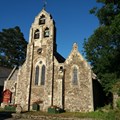Story
Have you been to Lamorran? We think its worth a visit. The church of St Moran stands in its lovely little churchyard, in an almost unique setting by Lamorran Creek on the Fal River in Cornwall. It is very quiet, off the beaten track. Theres a snag though - it has been closed since 2014 because of significant bat colonies.
The church is 13th C, listed Grade II*, and was last restored in 1853. If you go to Holy Trinity Tresillian website www.holytrinitytresillian.org.uk you will find three detailed articles on the bat project, the history of the church, and on some of the interesting historical figures associated with Lamorran over the years.
We have at least three bat colonies; a small colony of Greater Horseshoe bats, who roost in the detached belltower, and cause no offence to anyone; there is also evidence of Lesser Horseshoe bats roosting in the lower stage of the tower; and there is a rather larger colonies of brown Long Eared and Pipistrelle bats in the church. Lamorran is an almost ideal habitat for bats, particularly in that the surrounding mixed broadleaf woodlands with its insect population provides both shelter and an extensive feeding ground. The Long Eared bats are thought to roost in the church roof void, between the wooden ceiling and the slate roof covering, particularly along the line of the nave ridge. Bats are both determined and agile, and capable of squeezing through half inch or smaller gaps round doors and between ceiling boards; thus they gain access to the body of the church. Apart from feeding on butterflies and other insects, they use the nave and chancel as a flight training area for their young. The damage to the fabric of the church is quite extensive, both from their droppings, and their urine, which not only stains but corrodes.
Up to 2014, we held regular services at Lamorran, more or less on a monthly basis. In September of that year, preparations for Harvest Festival involved four people for half a day in cleaning, doing far more than mere dusting, only to have to carry out more work before the Sunday service. The recurrent cleaning had become an unacceptable burden, and the PCC resolved, with reluctance, to close the church until a solution could be found, something that at the time seemed hopeless. Here I should say that bats are a protected species, and it is illegal to interfere with them in any way without a license from Natural England, so we had little freedom of action. There have always been bats in churches, but in recent years, due both to loss of habitat and, particularly, loss of roost sites due to demolition and conversion of traditional farm buildings, churches have tended to become a last resort for some species of bat. This possibly explains how the problem has escalated at Lamorran.
In February 2015, out of the blue came an enquiry from Church House, Westminster did we have a bat problem? The answer being yes, our name went forward to Natural England, and, in short, after numerous bat surveys, and detailed design work and negotiation over five years, Lamorran has been fully accepted for the ground-breaking Bats in Churches Project, a partnership between Natural England, the Bat Conservation Trust, The Church of England, the Churches Conservation Trust, and the Heritage Lottery Fund. Remedial work, including the construction of two bat lofts and access provision, sealing of the congregational spaces, the nave, chancel and transepts to prevent access, and a costly operation to clean and restore the church furniture, is due to start on 1st March this year, 2021.
This work is primarily designed to facilitate peaceful co-existence between bats and people, without prejudice to the bat colonys future. It should also lead to a rejuvenation of church life at Lamorran, and we have to think about the future use of St Moran, which in turn requires people, people to undertake voluntary work, people to rebuild the congregation, and people to broaden the scope of its use. So far, the kernel of some ideas has emerged; firstly, building on Lamorrans horticultural connections, to use and promote Lamorran as a gardeners chapel; secondly, to run bat conservation days, seeing the bats as friends (which as Gods creatures they ought to be) possibly in conjunction with the Bat Conservation Trust or Cornwall Wildlife Trust; and to form a Friends of Lamorran group to give a focus for volunteers. However, having potentially dealt sympathetically with the bat colonies we also have a considerable backlog of outstanding repairs, which are summarised in our campaign description above, but without the financial resources to undertake them. Whilst the body of the church is wind and weathertight, and more or less presentable outside, reopening of the church is dependant upon our carrying out these repairs, and it is for this purpose that we have launched this appeal.
 Campaign by
Campaign by 